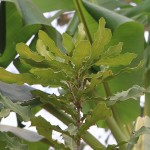Edible Nuts and Seeds that Grow in the Tropics
Surprisingly, there aren’t many familiar nuts and seeds that grow in the tropics. We have many varieties of fruit, veggies, and greens that grow here, but it’s a challenge to find edibles that give us a good sources of protein and oil. Nuts and seeds are also important to add variety in cooking, and are especially useful in gourmet raw food recipes, such as making nut butters or cheeses. They also are important for making great pestos. So, if you’re worried about the coming zombie apocalypse and want to be as self-sustainable as possible, nuts and seeds are a very important of a nutritious diet.
Unfortunately, many familiar nuts such as pecans, walnuts, and almonds, won’t grow in the tropics. However, there are several that do grow well here that we are experimenting with on the farm:
Breadnut
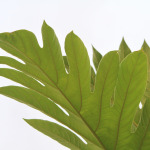 Currently, we have a breadnut tree that has grown to almost 20ft tall in only two years. After a few more, it will start producing huge spiky fruits that are so big they would kill you if they fell on you. Inside are small yellow fruits and inside those are large seeds that look and taste like chestnuts. Breadnuts are cherished by wildlife conservationists because these trees, when grown in the wild, or planted for reforestation purposes, drop their large fruits that become great foods for ground-dwelling foragers like deer or peccary.
Currently, we have a breadnut tree that has grown to almost 20ft tall in only two years. After a few more, it will start producing huge spiky fruits that are so big they would kill you if they fell on you. Inside are small yellow fruits and inside those are large seeds that look and taste like chestnuts. Breadnuts are cherished by wildlife conservationists because these trees, when grown in the wild, or planted for reforestation purposes, drop their large fruits that become great foods for ground-dwelling foragers like deer or peccary.
Cashews
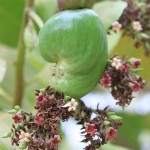 Cashews are a popular nut around the world, but when you see how they’re grown, it’s hard to imagine how there’s enough of them to supply the demand. The reason for that is each nut is attached to a large cashew “apple” fruit. Plus, the nuts come inside a hard shell covered with a toxic oil that has to be carefully burned off. So when see a cashew tree it appears that it would take an entire tree to make one can of nuts. So think about that the next time you are about to complain about the cost of a can of them. Cashews are great in many foods and can be blended up to make cashew cheese. Click for more about: Cashews
Cashews are a popular nut around the world, but when you see how they’re grown, it’s hard to imagine how there’s enough of them to supply the demand. The reason for that is each nut is attached to a large cashew “apple” fruit. Plus, the nuts come inside a hard shell covered with a toxic oil that has to be carefully burned off. So when see a cashew tree it appears that it would take an entire tree to make one can of nuts. So think about that the next time you are about to complain about the cost of a can of them. Cashews are great in many foods and can be blended up to make cashew cheese. Click for more about: Cashews
Chan
 Chan is a local version of chia, but the small edible seeds are much more irregular-looking, and they are available raw in every grocery store in Costa Rica. Although I’ve never seen it growing wild here, the chan plant is native invasive weed, and we have been warned that if we plant the seeds we can expect to have them growing all over the farm. Sounds great to us, so we dived right in. The scientific name for chan is “Hyptis suaveolens” and it’s in the mint family. It’s used primarily as a medicinal drink. The seeds are soaked in water, forming a gelatinous liquid, and that is then chilled. People here in Costa Rica drink it for relief from indigestion, gastritis and constipation.
Chan is a local version of chia, but the small edible seeds are much more irregular-looking, and they are available raw in every grocery store in Costa Rica. Although I’ve never seen it growing wild here, the chan plant is native invasive weed, and we have been warned that if we plant the seeds we can expect to have them growing all over the farm. Sounds great to us, so we dived right in. The scientific name for chan is “Hyptis suaveolens” and it’s in the mint family. It’s used primarily as a medicinal drink. The seeds are soaked in water, forming a gelatinous liquid, and that is then chilled. People here in Costa Rica drink it for relief from indigestion, gastritis and constipation.
Chia
 Chia is similar to chan, but the seeds are more regular in shape, they’re more nutritious, and they aren’t native to Costa Rica. Chia grows well in the tropics, producing a bush up to about 2m high with tiered purple flowers. The seeds are tiny and tricky to harvest, but they’re so useful and healthy that it’s worth it to harvest a few for special occasions. Their main health benefit is that chia is one of the few edible plant foods in the world that contains all the essential amino acids, so for vegetarians and vegans, it’s a great food to take daily. One of its best uses is to make pudding. To do that, soak it in a liquid overnight, perhaps with raw cacao and honey, and then blend it the next morning to make chocolate pudding. Chia also makes a great pet.
Chia is similar to chan, but the seeds are more regular in shape, they’re more nutritious, and they aren’t native to Costa Rica. Chia grows well in the tropics, producing a bush up to about 2m high with tiered purple flowers. The seeds are tiny and tricky to harvest, but they’re so useful and healthy that it’s worth it to harvest a few for special occasions. Their main health benefit is that chia is one of the few edible plant foods in the world that contains all the essential amino acids, so for vegetarians and vegans, it’s a great food to take daily. One of its best uses is to make pudding. To do that, soak it in a liquid overnight, perhaps with raw cacao and honey, and then blend it the next morning to make chocolate pudding. Chia also makes a great pet.
Jackfruit Seeds
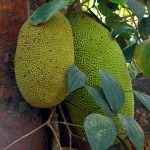 Jackfruit are the largest fruits in the world. They look like the breadnut, but are even larger, and could destroy your car if they fell on it. The fruit’s stringy bits I’ve been told make a great curry, as they’re a bit spicy. Just one jackfruit can have 100-200 seeds that are around the size of a brazil nut. They can be used for many things, but one visitor to the farm told me how to make a great hummus out of boiled seeds. Here’s a link to a tasty-sounding recipe: jackfruit seed hummus
Jackfruit are the largest fruits in the world. They look like the breadnut, but are even larger, and could destroy your car if they fell on it. The fruit’s stringy bits I’ve been told make a great curry, as they’re a bit spicy. Just one jackfruit can have 100-200 seeds that are around the size of a brazil nut. They can be used for many things, but one visitor to the farm told me how to make a great hummus out of boiled seeds. Here’s a link to a tasty-sounding recipe: jackfruit seed hummus
Macadamias
We have three macadamia seedlings that are slowly growing. We were told to plant them with good drainage, so they’re on a sloped area, planted with a deep hole that has gravel in it, and the hole is open to the side of the hill. The idea is to let any excess water filter out more easily and prevent root rot. It will probably be a few more years before the nuts start coming in, if we’re lucky, but hopefully we’ll probably be the first people in this part of Costa Rica to have our own macadamia trees. These nuts are one of the tastiest nuts there is, are the favorite of many people, so we’re really hoping to be blessed with success with this one. The seedlings were expensive and brought from the Central Valley, so if we can prove they’ll work here, it would be great to plant a few dozen of them somewhere else on the farm. Macadamias are good in all kinds of cooking, and especially in pestos. They also make a great crust for baked or fried fish.Peach Palm / Pejibaye
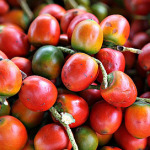 Pronounced pay-hee-BAH-jay in Spanish, this is actually the fruit of a type of palm tree that’s very popular in Costa Rica. The palm it comes from also produces “heart of palm” but you have to cut down the tree to harvest it. This starchy fruit is boiled in very-salty water for 1-3 hours and then tastes something like a sweet potato. It’s dry, so it’s popular to put something like mayonnaise on it. The peach palm is very heavy in Vitamins A and C. The reason I mention it here in this list, is not just because it looks like a nut, but because it’s a great source of protein because it one of the world’s only foods that contains all the nine essential amino acids. It’s lowest in tryptophan, but you can get that from beans, cashews, sunflower seeds, and other sources.
Pronounced pay-hee-BAH-jay in Spanish, this is actually the fruit of a type of palm tree that’s very popular in Costa Rica. The palm it comes from also produces “heart of palm” but you have to cut down the tree to harvest it. This starchy fruit is boiled in very-salty water for 1-3 hours and then tastes something like a sweet potato. It’s dry, so it’s popular to put something like mayonnaise on it. The peach palm is very heavy in Vitamins A and C. The reason I mention it here in this list, is not just because it looks like a nut, but because it’s a great source of protein because it one of the world’s only foods that contains all the nine essential amino acids. It’s lowest in tryptophan, but you can get that from beans, cashews, sunflower seeds, and other sources.
Peanuts
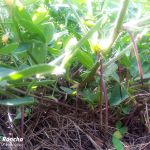 I was delighted to discover that peanuts grow well in the tropics and adore the heat. They also have one of the most interesting growing methods of any plant. You plant them by carefully removing the nuts from the shell, keeping the thin skin attached, and they quickly grow into small bushes around 12 inches high. After a month or so, they send down roots that reach down into the soil. Each root tip will produce a new peanut just under the soil. In our case, our entire first crop was lost to rats. Our second crop was invaded too, but we waited too long and it started regrowing. You have to pull them out at the right time, and hang them to dry and harvest. The best use of peanuts is to make thai peanut sauce, by cooking ground up peanuts with coconut milk and curry. It’s good on everything.
I was delighted to discover that peanuts grow well in the tropics and adore the heat. They also have one of the most interesting growing methods of any plant. You plant them by carefully removing the nuts from the shell, keeping the thin skin attached, and they quickly grow into small bushes around 12 inches high. After a month or so, they send down roots that reach down into the soil. Each root tip will produce a new peanut just under the soil. In our case, our entire first crop was lost to rats. Our second crop was invaded too, but we waited too long and it started regrowing. You have to pull them out at the right time, and hang them to dry and harvest. The best use of peanuts is to make thai peanut sauce, by cooking ground up peanuts with coconut milk and curry. It’s good on everything.
Pumpkin Seeds
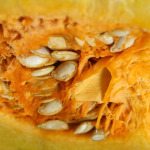 Pumpkins are just an orange version of squash, and here squash is called “Ayote.” The seeds are highly nutritious, and when you let any ayotes, squashes, or pumpkins grow too long, they get tougher and lose their flavor. But fear not, because that’s when they’ll produce lots of seeds. The problem is getting the seeds out of their hulls, which isn’t easy to do in quantity. The secret is to grow pumpkins that have hull-less seeds, also known as “naked” pumpkin seeds! So if you grow the right kind, you can press them to make pumpkin seed oil, or roast them to eat in many ways. A few varieties of pumpkins that have naked seeds are Lady Godiva, Gleisdorfer, and Kakai.
Pumpkins are just an orange version of squash, and here squash is called “Ayote.” The seeds are highly nutritious, and when you let any ayotes, squashes, or pumpkins grow too long, they get tougher and lose their flavor. But fear not, because that’s when they’ll produce lots of seeds. The problem is getting the seeds out of their hulls, which isn’t easy to do in quantity. The secret is to grow pumpkins that have hull-less seeds, also known as “naked” pumpkin seeds! So if you grow the right kind, you can press them to make pumpkin seed oil, or roast them to eat in many ways. A few varieties of pumpkins that have naked seeds are Lady Godiva, Gleisdorfer, and Kakai.
Sesame Seeds
Sesame will grow in the tropics, which we proved once, but we found the seeds from that plant didn’t re-grow. So we’ve been stuck without sesame seeds for a while, waiting for another supply to appear, hopefully from Costa Rica where they’ve been naturalized. Sesame seeds have hulls that can make them more bitter, and a special machine is needed to remove them, but you can also just eat them. With sesame seeds you can make tahini by grinding them up with a bit of olive oil. If anyone out there knows a good local supplier for sesame seeds (for planting) please let us know!Sunflower Seeds
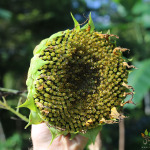 Sunflowers are another of nature’s most amazing plants. What other flower you can think of is so big and covered with huge tasty seeds? Here at the farm we have mainly been growing them as tests, and often they never reach maturity because they are growing alone and get knocked down by wind, birds, animals, etc. They’re super pretty to have around the farm, but if we’re going to get serious about growing them in quantities we’ll need to plant a field of them somewhere. Then the next problem will be how to get them out of their hulls…
Sunflowers are another of nature’s most amazing plants. What other flower you can think of is so big and covered with huge tasty seeds? Here at the farm we have mainly been growing them as tests, and often they never reach maturity because they are growing alone and get knocked down by wind, birds, animals, etc. They’re super pretty to have around the farm, but if we’re going to get serious about growing them in quantities we’ll need to plant a field of them somewhere. Then the next problem will be how to get them out of their hulls…













